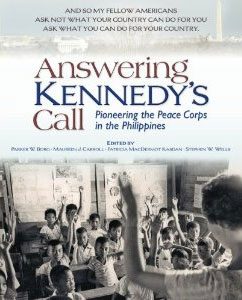 Reviewed by Richard Gilbert
Reviewed by Richard Gilbert
Borg, P., Carroll, M.,Kasdan, M., Wells, S. (editors), Answering Kennedy’s Call: Pioneering the Peace Corps in the Philippines, Peace Corps Writers Publishers, ISBN 13: 978-1935925019, 505 pp. Paperback, $25.00.
After fifty years (1961-2011), the Peace Corps has become, in the minds of Americans and many others in nations around the globe, an icon of what’s good about our country and our people. Much of the credit for the success and endurance of the Peace Corps is attributable to the irrepressible enthusiasm and optimism of the Peace Corps’s first Director, Sargent Shriver; the field staff of free-thinking, creative Kennedyites he recruited to build and shape the first programs abroad; and to the early volunteers, uncommonly average Americans every one, who answered Kennedy’s siren call. Answering Kennedy’s Call: Pioneering the Peace Corps in the Philippines is their story, a remarkable collection of memoirs capturing the lives and experiences of some of the first volunteers who served in the Philippines, the nascent Peace Corps’ largest program, during 1961-63. Written with the benefit of wisdom that comes with a half century of perspective, their stories are at once poignant, funny, insightful and revealing. Sent abroad in large numbers to wage good in an American client state, with little relevant training beyond an admonition to “roll with the punches” and a job definition that satisfied no one, they managed to fulfill the first law of volunteerism—First, Do No Harm—while building a quiet, barely-noticed record of micro-achievement in the tiny barrios and small towns of the benighted Philippine archipelago. Individually, their stories admit to the difficulties and frustrations of the task, from the simple challenges of daily living to disappointments generated by aspects of traditional Filipino culture to persisting guilt born from the certain knowledge that they were receiving more than they were giving. Yes, there’s even “the world’s worst Peace Corps volunteer” hiding among the many roses (take a bow, Richard). In sum, this is a book for all returned Peace Corps volunteers (there are 200,000 of them out there), for Filipinos curious about those strange Americans who lived (and still live) among them and for folks simply interested in the folkways of the early sixties in America and the motivations that propelled early Peace Corps volunteers. Here are the stories behind the icon, a very American book from which we can all take a measure of pride.

About the Author: Richard Gilbert is a retired USIA officer and occasional contributor to American Diplomacy. During his career, he served in Bangkok, Bucharest, Helsinki, Monrovia, Moscow and Santiago in addition to assignments in Washington. He lives at present in New York, where his spouse is assigned to the United States U.N. Mission.
